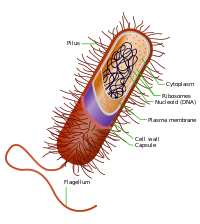
Photo from wikipedia
Bacterial pathogens have developed intriguing virulence mechanisms, including several sophisticated nanomachines, for injecting effector proteins to manipulate host immune signaling pathways for their own benefit. Therefore, bacterial genomes harbor a… Click to show full abstract
Bacterial pathogens have developed intriguing virulence mechanisms, including several sophisticated nanomachines, for injecting effector proteins to manipulate host immune signaling pathways for their own benefit. Therefore, bacterial genomes harbor a wealth of information about how to manipulate the defense systems of the host. Current understanding addresses virulence mechanisms mostly as targets for antimicrobials. We propose a change of paradigm by exploiting bacterial effectors not as targets but as tools for the directed manipulation of host signaling - for the benefit of the host. Recently, effector proteins have been identified that autonomously translocate into host cells, representing a novel class of cell-penetrating peptides (CPPs) or effectors (CPEs). Moreover, autonomous cell penetration overcomes a major hurdle in pharmacology by transducing specific therapeutic agents to intracellular targets.
Journal Title: Trends in biotechnology
Year Published: 2017
Link to full text (if available)
Share on Social Media: Sign Up to like & get
recommendations!